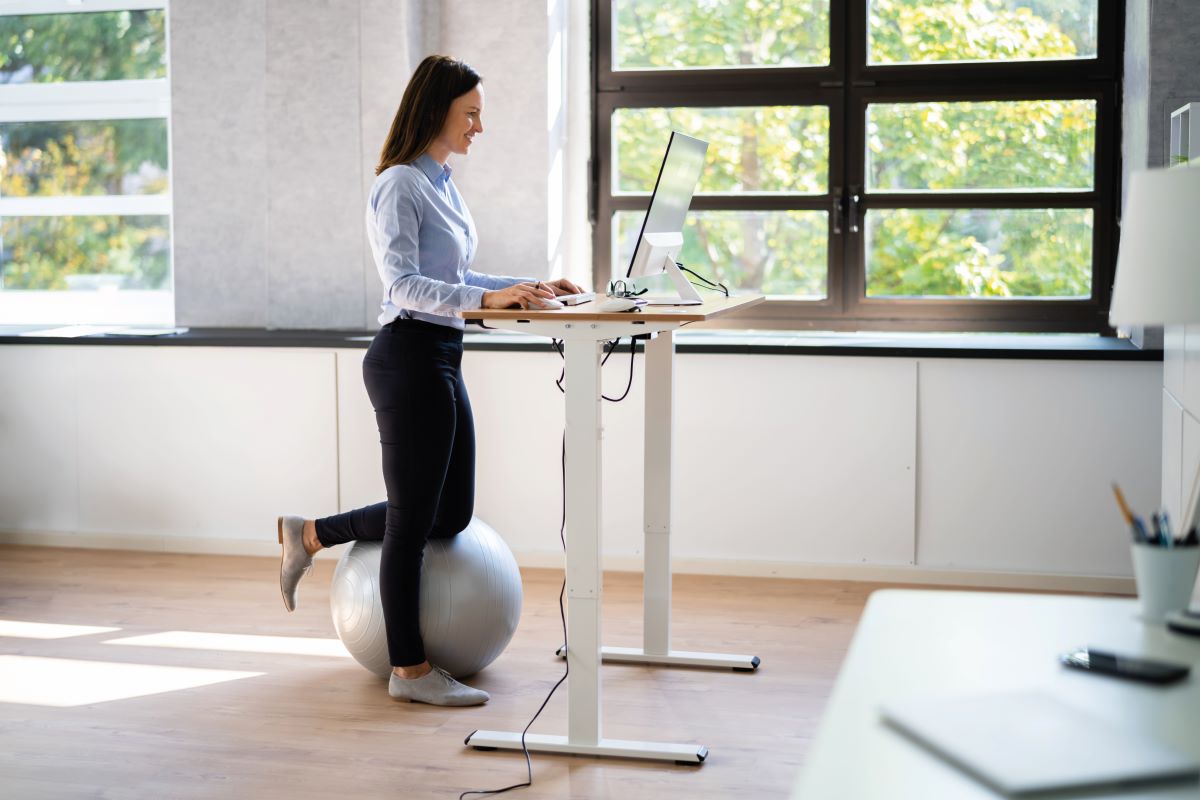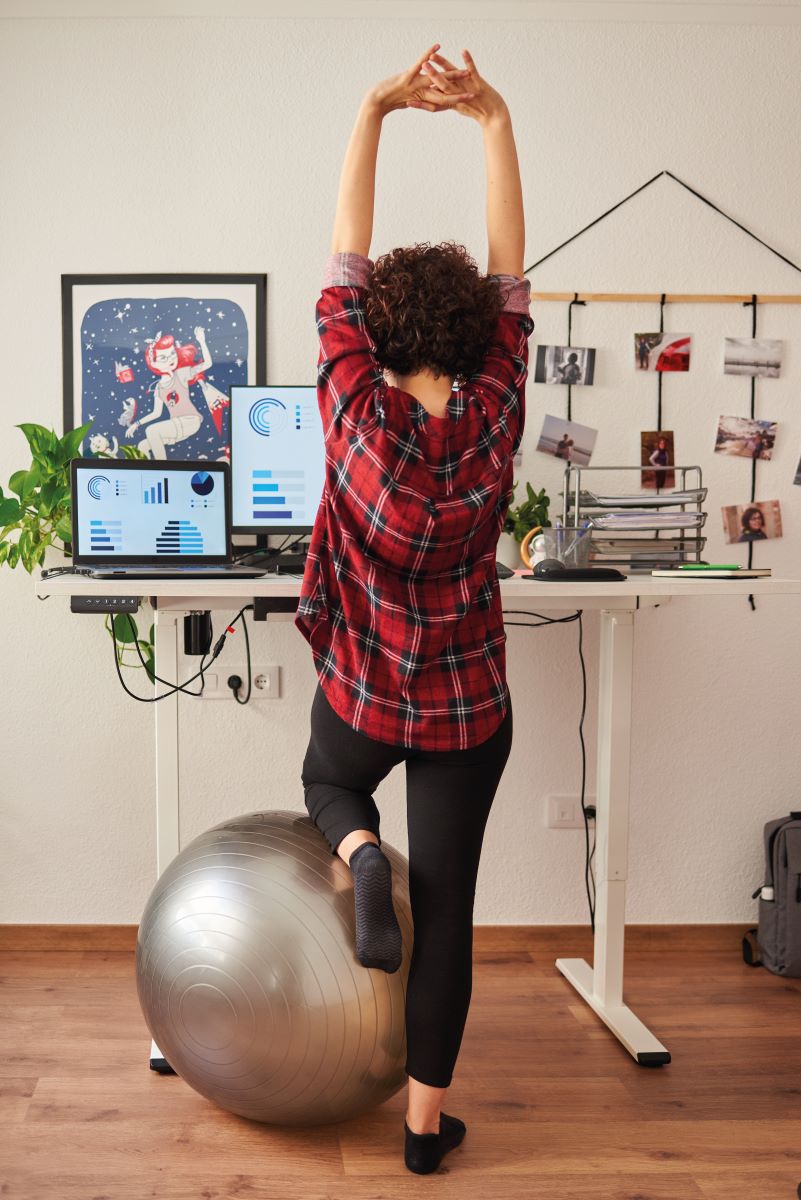You love your job and wouldn’t change it for the world, but if it involves sitting at a desk for long hours, it should probably come with a health warning. Let’s take a closer look at the dangers of sitting all day…
You’ve had a good day – the report is finished, your emails are up to date and you’ve even written a proposal for a new project. Unfortunate, then, that all this productivity comes at a price. We’ve known for some time that being inactive for long hours carries with it an increased risk of chronic illness, but with working from home adding an average two hours per day to our time spent sitting, it’s never been more important to get moving.
Related: 26 ways to be more active throughout the day
Is it dangerous to sit all day?
‘A plethora of medical research has shown that sedentary behaviour increases the risk of cardiovascular disease, type-2 diabetes, high blood pressure, cancer, osteoporosis and depression,’ says Dr Deborah Lee, from Dr Fox Online Pharmacy. ‘It also increases the risk of overall mortality.’
And the research keeps coming. A study published just last month shows the amount of time you sit could increase breast cancer risk by as much as 104 per cent.
Read on to discover exactly how too many hours on your bum is affecting your health, and what you can do to minimise the risk.
10 dangers of sitting all day
1. Musculoskeletal system damage
You might expect the odd twinge after sitting at your desk all day, but the impact on your musculoskeletal system goes much further. ‘When we sit, we often slump and become kyphotic [have an excessively rounded spine], our upper back muscles disengage, and tendons and connective tissue around the upper chest tighten. Our hip flexors shorten, and sitting on our derrière too long tells our glutes they don’t need to work, so our quads start doing the work, instead,’ explains PT and movement coach, Dan Roberts.
All of this will impact your workouts, too. ‘If you sit all day and then cycle, for example, chances are you’ll carry over your bad posture and quad dominance. If you love running or cycling, do some bodyweight hip thrusts as part of your warm-up to wake up your glutes.’
2. Increased blood glucose levels
Alarmingly, sitting has a major impact on many of your body’s other systems as well. Exercise helps your body store glucose in your muscles, but sitting has the opposite effect. ‘Blood glucose levels are elevated during periods of inactivity, which induces insulin resistance, and the risk of type-2 diabetes increases in relation to the proportion of time spent being inactive,’ warns Dr Lee.
3. Risk of heart disease increases
Disturbingly, your heart disease risk increases, too. ‘Inactivity is known to suppress production of an enzyme known as LPL (lipoprotein lipase), found in skeletal muscle and fat tissue,’ she adds. ‘It breaks down triglycerides and leads to impaired fat metabolism, both of which are risk factors for atherosclerosis.’
4. Increased risk of cancer
Another concern about sedentary lifestyles is the increased susceptibility to various cancers. ‘Latest figures suggest lung cancer increases by 54 per cent, uterine cancer by 66 per cent and colon cancer by 30 per cent,’ Roberts confirms.
The reason? Along with a higher chance of inflammation due to the weight gain that accompanies being sedentary – ‘chronic inflammation can trigger the production and growth of cancer cells,’ warns Dr Lee – sitting can also lead to the circulation of steroid hormones. ‘This may be one reason why physical inactivity increases the risk of hormone-dependent cancers,’ she adds.
5. Brain health risks
If all this wasn’t enough to make you jump out of your chair, being sedentary can even affect your brain health, with research linking it to thinning of the medial temporal lobe which is connected to formation of new memories.
‘During vigorous aerobic exercise, muscles secrete proteins, which travel to the brain and provoke neurogenesis (the growth of new brain cells). However, many of the benefits are eliminated by sitting down for more than 10 hours a day,’ warns Professor James Goodwin, director of science and research impact at Brain Health Network.

How to avoid a sedentary lifestyle
Do standing desks help?
So how can you mitigate the effects of long hours sitting? One method that’s been gaining traction recently is sit-stand desks, with recent research showing an increase in productivity of 23 per cent in the first month of use, building to 53 per cent over a six-month period.
No-brainer, you might think, but unfortunately, things aren’t so simple, as long hours standing has also been shown to double the risk of heart disease. ‘Interestingly, when it comes to the negative health effects of sitting, the same issues apply to standing at a standing desk,’ says Roberts.
‘It’s more about the lack of movement than the actual position. Having said that, I’m a fan of standing desks as people are far more likely to walk around when already standing.’ The key is to alternate between the two ways of working, and keep moving in between (tips below on how to stay active at your desk).
Under-desk exercise
If you’re not keen on a standing desk, you might prefer under-desk exercise. At its simplest, portable pedal machines make sitting an active rather than passive activity, with research finding after three months’ use, participants reduced their sedentary time by almost an hour a day, according to Dr Lee.
Other options are more sophisticated, and include specially designed exercise bikes, treadmills or ellipticals – all of which help blood circulation. ‘In my opinion the best by far is a treadmill, as you’re upright so it eliminates posture problems (glute deactivation, tight hip flexors and kyphosis),’ says Roberts.
Build a movement routine
Not sure where to start? Like any new movement practice, having a plan and building up slowly is a good place to start. ‘On week one, you could do 30 minutes a day, then add 15 minutes every week,’ he suggests. ‘Or use your under-desk exerciser whenever you have to read a report or watch a presentation.’
Above all, the most important thing is to move regularly, says Kendall Scales, consultant physiotherapist at Ten Health & Fitness (ten.co.uk). ‘Fidget. Get up and walk around as much as possible. Make your calls standing up. Every hour or so, do some stretches to mobilise your spine,’ she advises. ‘And don’t eat lunch at your desk! Finally, if you’re working from home or your workstation set-up is not ergonomic, do all the above twice as much!’
Related: How to be healthy in an office job

3 ways to stay active at your desk
Try these desk-based exercises to prevent muscles becoming tight, weakened or out of balance.
Do pistol squats when you stand up
‘When standing up from your chair, do it on one leg. Known as a pistol squat, this exercise develops leg and glute strength, engaging your ankle, knee stabiliser muscles and your core. If it’s too hard, lean forward more, and if it’s too easy, lower your seat.’ – Dan Roberts
Move your spine regularly
‘Move your spine. Using the chair back for leverage, do a seated twist to each side. Next, extend one arm overheard, opposite hand resting on side of seat, and bend laterally to that side. Then, place hands in reverse namaste (or grasp elbows behind back), lift your chest and draw elbows and shoulders back. Take five deep breaths in each pose.’ – Eve Boggenpoel
Get up every 30 minutes
‘Get up and walk or move for one-to-two minutes every 30 minutes. Sit with your hands on your hips, spine straight and tilt your pelvis forward, increasing the curve in your lower back, then tilt your pelvis backwards, flattening the curve. Next, stand up, interlace your fingers behind your back and reach your fist towards the floor, opening the front of the chest, and slowly look up towards the ceiling.’ – Kendall Scales
Words: Eve Boggenpoel | Images: Shutterstock
Related: Active recovery workout sequence to try on rest day







